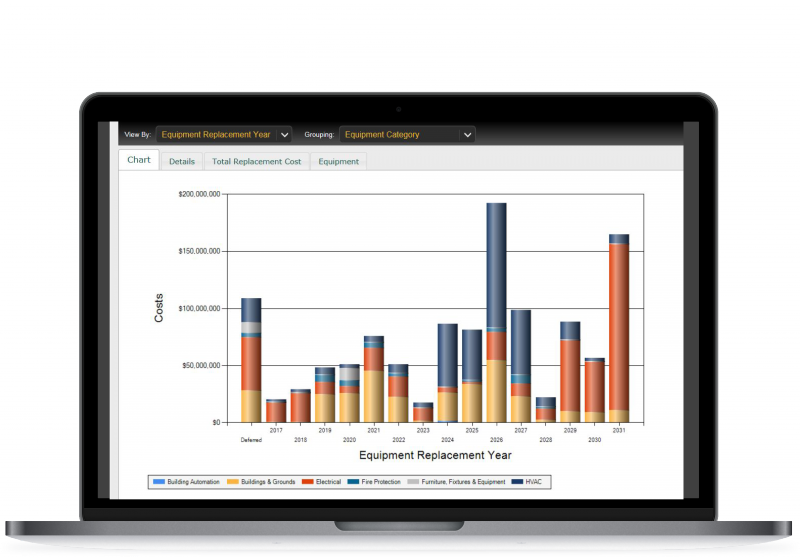How to Perform a Cost-Benefit Analysis
for Geospatial Analytics Asset Insite™

Estimating Net Benefits from Improved Decision Making
Geospatial Analytics Asset InSite™ is a data analytics tool that enables you to analyze the data gathered using Geospatial Analytics Inspection InSite™ that resides in the Geospatial Analytics Info InSite™ database (or using your existing in-house capabilities). In the absence of an enterprise asset management solution, the legacy decision making process for assets can be inefficient and inconsistent, and can complicate optimization of total cost of ownership and risk management.
Geospatial Analytics Asset InSite™ provides asset owners and managers with a strategic planning process that aggregates data regarding the condition of assets in your facility portfolio. This provides a better understanding of the condition and costs of your entire enterprise asset portfolio, as opposed to managing it on a facility-by-facility basis.
The crux of the cost-benefit analysis includes:
- Estimating in-house annual savings using these capabilities either
in the aggregate or by asset category. - Subtracting the cost of the solution’s license fee to determine the
net savings. - Estimating savings in future years and applying a discount rate to
determine the net present value of the total savings.
This powerful tool empowers you to:
- Purchase equipment and parts in bulk at a savings.
- Use a consistent, objective approach to purchasing.
- Optimize your total cost of ownership by optimizing
asset repair and replacement. - Perform asset risk management and capital planning.
Examining each of these capabilities
provides ways to perform such a cost-benefit analysis:
Enhanced Volume Purchasing
Geospatial Analytics Asset InSite™ identifies opportunities for asset owners to consolidate purchasing for all equipment types — purchasing more types of equipment from a single supplier (i.e., supplier rationalization) identification of “should-cost” pricing, and reduction in markups by purchasing directly from the source (instead of purchasing through general contractors or third parties).
The tool also enables bundling of projects to obtain volume discounts. To calculate these savings, you can estimate the percentage of equipment (by dollars or number of units) that you can reasonably assume can be impacted by supplier rationalization and/or volume discounts, and the assumed percentage of pricing reduction. You can then apply this percentage to the applicable current dollar spend by equipment type, facility, or enterprise-wide.
More Objective Purchasing Approach
Geospatial Analytics Asset InSite™ enables asset owners to apply a consistent process and standard for making purchasing decisions, as an alternative to ad hoc decision making based on criteria that may not be quantitatively defendable. Constructed using knowledge of the precise condition of all assets using Geospatial Analytics Asset InSite™ enables objective purchasing decision making based on enterprise-wide standards. This eliminates the replacement of assets that are subjectively selected for replacement but have useful remaining life or low risk if they fail prior to replacement.
To calculate these savings, you can estimate the percentage of equipment (by dollars or number of units) that you can reasonably assume will not have to be replaced, along with the assumed percentage of cost reduction. You can then apply this percentage to the applicable current dollar spend by equipment type, facility, or enterprise- wide.
Reduced Total Cost of Ownership
Geospatial Analytics Asset InSite™ enables asset owners to optimize asset repair versus replace decisions across asset types, individual facilities, and corporate portfolios. By transforming data into business intelligence on asset condition, sophisticated analytics can facilitate significant process improvements. For instance, preventative maintenance can be reduced for newer assets or can be eliminated for assets with very low operational risk. As a result, the tool helps asset owners minimize the total cost of ownership — including acquisition, operation, maintenance, repair, and disposal — of their assets.
To estimate these savings, you can estimate the percentage of maintenance (by dollars or some other measure) that you can reasonably assume can be optimized, along with the assumed percentage of lifecycle cost savings. You can then apply this percentage to the applicable current dollar spend by equipment type, facility, or enterprise-wide.
Improved Risk Management
Geospatial Analytics Asset InSite™ enables asset owners to perform asset risk management analysis. Risk is the product of probability of an occurrence and the impact of the occurrence. Your risk tolerance is likely to vary from asset type to asset type, and also, from one application of the asset to another. For example, if the probability of failure of a particular type and age of HVAC system is constant, but the impact of this HVAC failure in your data center is much greater than the impact of the HVAC failure in your office or warehouse, then the risk is higher for the data center HVAC system. Therefore with a limited capital budget, you would prioritize replacing the HVAC system serving the data center before replacing the warehouse HVAC system. While the decision in this example is obvious, it is a much more complex exercise when dealing with tens of thousands of assets that support hundreds of different facilities. Sophisticated analytics are needed to evaluate the data and help form an optimized capital budget that maximizes the value creation within limited financial constraints. Geospatial Analytics Asset InSite™ enables you to make these and other critical evaluations based on hard condition data and a risk-informed process.
To estimate cost savings due to enhanced risk management, you can select a critical function such as a call center, data center, or critical manufacturing assembly line, and assume that you can avoid an outage of this function for some period of time typical of a critical equipment failure. You can estimate the outage cost of that failure using past cost data you have gathered or by other measures such as loss of sales. In addition, you can assume that enhanced risk management enables you to repair equipment, rather than replace it, in non-critical functions, or allow an asset to “run to failure,” thus deferring a significant capital outlay for some period of time.
Case
Studies
Cost Benefit Analysis
More
Solutions


